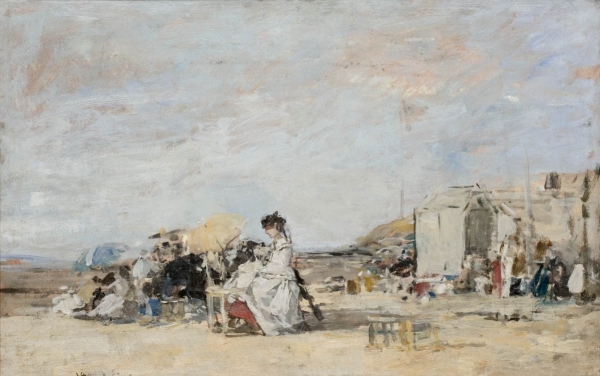Boudin, Lady in White on the Beach at Trouville

Eugène BOUDIN (1824-1898)
Lady in White on the Beach at Trouville
1869
oil on board
31.4 x 48.6 cm
© MuMa Le Havre / Florian Kleinefenn
Lady in White on the Beach at Trouville
1869
oil on board
31.4 x 48.6 cm
© MuMa Le Havre / Florian Kleinefenn
HD image
podcast
In his account of the Salon of 1869, art critic Castagnary wrote that painter Eugène Boudin (1824–1898) had hit upon a new genre of seascape "which consists of painting the beach and all those exotic figures from high society whom summer brings to our coastal resorts". Between 1860 and 1896, Boudin executed nearly three hundred paintings on the theme of these "crinoline" beaches. While his early beach scenes focused on outdoor recreation, by 1890 his paintings had become vast seashores, scarcely dotted with a few distant silhouettes.
Boudin painted his first beach scenes around 1860, prompted by his friend Ferdinand Martin. The genre was an immediate success with art enthusiasts, to such an extent the artist wrote in a letter to his brother in 1865: "I shall do other things, but I will always be the painter of beaches."
Lady in White on the Beach at Trouville is a typical painting from this particularly prolific period. Boudin composed his work in three horizontal registers with subtle hues that retain the softness of watercolour and light brushstrokes that leave glimpses of the undersurface peeking through.
Rather than attempting to create individual silhouettes, the artist took a panoramic approach to capture the seaside crowd like a fresco in the middle space between beach and sky. The absence of precise contours and the way the figures blend into the scene help evoke this society as a whole. Boudin conveys here the very essence of modern life. His lightness of touch with regard to variations of light and cloud movement prefigured the exploration of the Impressionists.
Boudin painted his first beach scenes around 1860, prompted by his friend Ferdinand Martin. The genre was an immediate success with art enthusiasts, to such an extent the artist wrote in a letter to his brother in 1865: "I shall do other things, but I will always be the painter of beaches."
Lady in White on the Beach at Trouville is a typical painting from this particularly prolific period. Boudin composed his work in three horizontal registers with subtle hues that retain the softness of watercolour and light brushstrokes that leave glimpses of the undersurface peeking through.
Rather than attempting to create individual silhouettes, the artist took a panoramic approach to capture the seaside crowd like a fresco in the middle space between beach and sky. The absence of precise contours and the way the figures blend into the scene help evoke this society as a whole. Boudin conveys here the very essence of modern life. His lightness of touch with regard to variations of light and cloud movement prefigured the exploration of the Impressionists.





